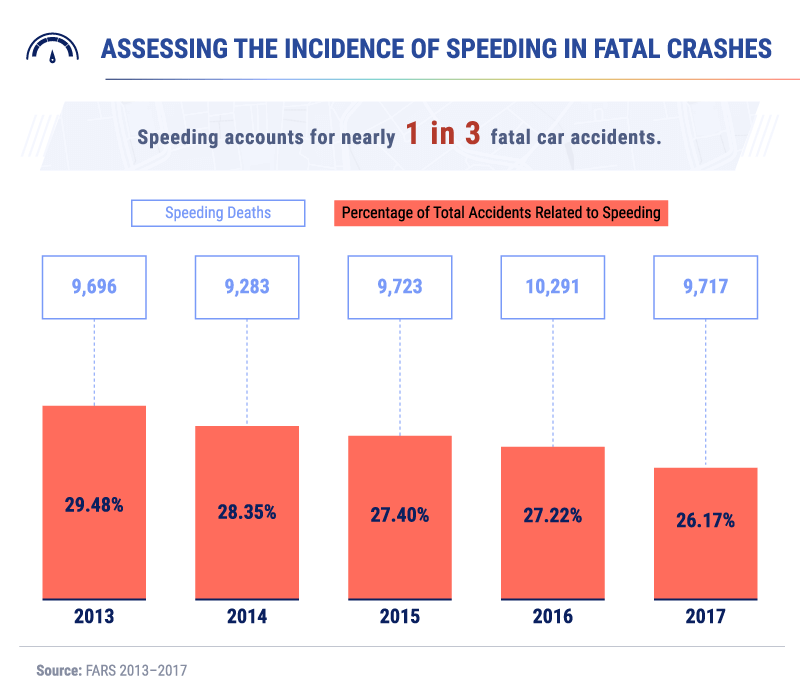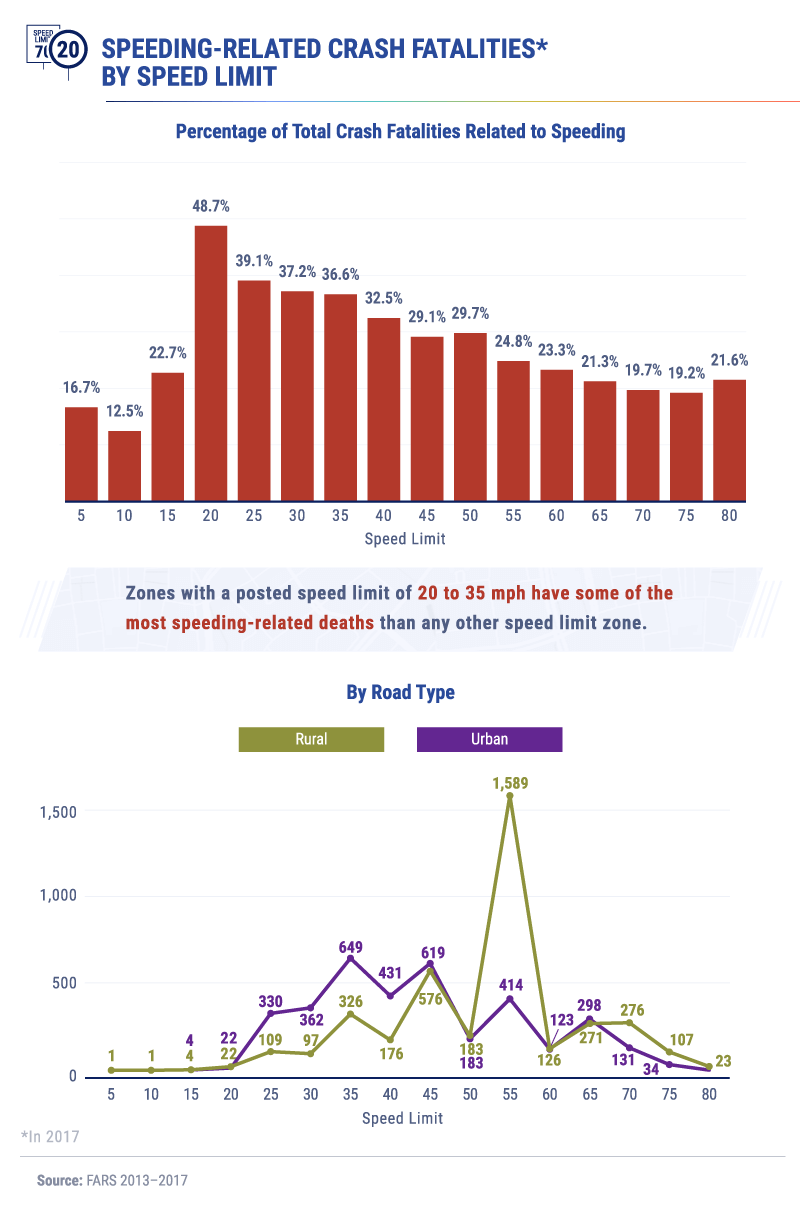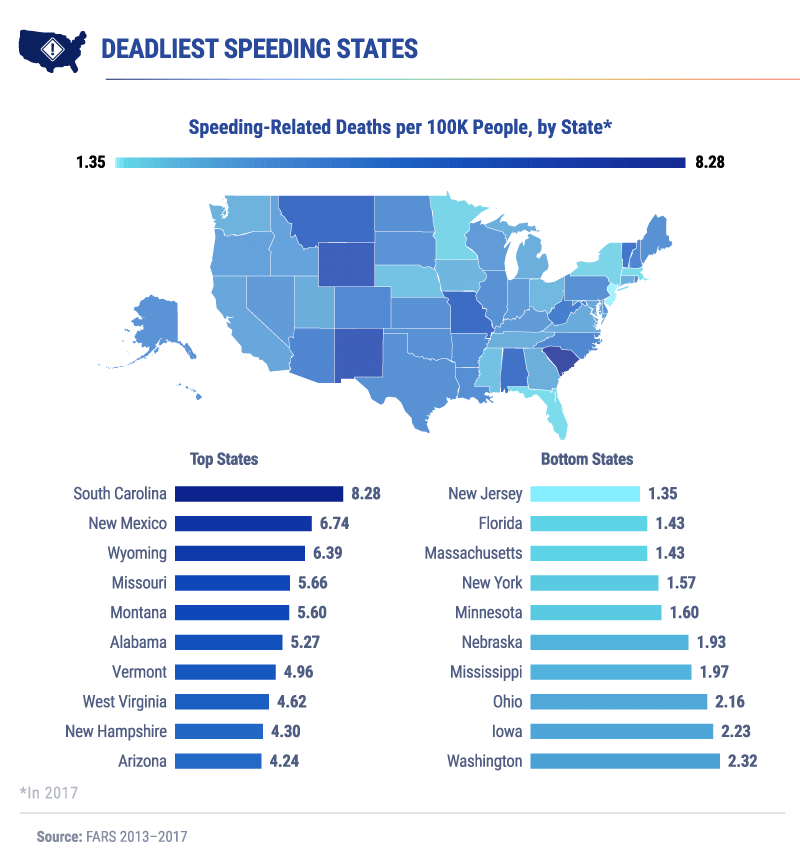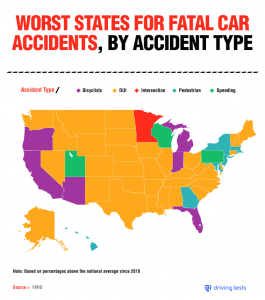- Speeding’s Role in Deadly Accidents
- Was Speeding a Factor?
- Age and Gender Gap
- Regional Mortality Rates
- Dangerous Roadways
- Safety First
In the time that it takes you to read this report from start to finish, at least one person somewhere in the U.S. will have died in a fatal car accident. Of the more than 37,000 fatal car accidents that occur every year (averaging one every 14 minutes), roughly 1 in 3 collisions involve a driver traveling above the legal speed limit.
A danger to everyone on the road, drivers who speed kill thousands of people every year as a result of not being able to control their vehicles properly, having insufficient time to avoid dangerous situations, and the diminished effectiveness of safety restraints. In short, speeding is often a reckless, unnecessary behavior that can lead to deadly accidents in the blink of an eye.
But how have speeding accidents changed over time, and which drivers are the most susceptible to fatal accidents at accelerated speeds? To learn more, we analyzed five years of Fatality Analysis Reporting System (FARS) data, including every fatal car crash involving a speeding driver between 2013 and 2017. Read on as we break down which speed limits drivers are most likely to disobey (leading to fatal crashes); how these tragic collisions vary from rural to urban roadways; and which drivers are the most likely to be involved in deadly accidents caused by a speeding driver.
Speeding’s Role in Deadly Accidents
Americans are logging more miles in their cars than ever before, and despite the efforts of major manufacturers to help make cars safer with the advent of new technology, in-car tech features could be leaving drivers more distracted instead. Even the noises a car makes to help alert drivers that they might be drifting into a different lane can be viewed as distracting, encouraging drivers to take their eyes (and their focus) off the road in front of them.

Between 2013 and 2017, the total number of fatal accidents caused by speeding on American roads fluctuated between 9,283 and 10,291, accounting for 26% to 29% of all deadly collisions.
When it comes to the most common causes of roadway accidents, their effects are significantly compounded when one or both drivers are traveling above the posted speed limit. From encountering blind spots on the road to distracted driving and losing control of your vehicle, the actions that regularly lead to collisions can turn from dangerous to deadly when speeding is involved.
Was Speeding a Factor?
If the speed limits in a given area sometimes seem arbitrary from one neighborhood to the next, that’s because they might just be.

According to the Federal Highway Administration, municipalities currently have no agreed-upon metric to determine the appropriate speed limits on roads or freeways. Instead, legislators take a combination of crash risk, traffic volume, roadway design, and location information into consideration to determine how fast drivers should be able to travel without endangering themselves or the people around them.
As we found by examining 2017 crash data, the highest volume of fatal accidents occurred on roads with 55 mile-per-hour speed limits, for a total of 2,003 speed-related fatalities. In all, speeding accounted for more than one in four deadly collisions that occurred on roads where drivers should be traveling at or under 55 mph. Overwhelmingly, roughly three quarters of fatal accidents on roads with 55 mile-per-hour speed limits took place in rural environments compared to urban area roadways. Despite the fact that they have less traffic, drivers are sometimes more likely to speed on rural roads where there’s less natural protection or lighting to illuminate dangers that may lie ahead.
Deadly accidents were significantly more common on roads with posted speed limits below 55 mph than in places where drivers can legally go 60 mph or faster. In fact, roadways accommodating the highest legal speeds saw some of the lowest proportions of fatalities attributable to speeding. Such was the case for roads limited to 75 mph, where speeding was culpable in fewer than one in five deaths.
Age and Gender Gap
Despite being socially stereotyped as “bad drivers,” research suggests women may actually be the safer and more cautious sex behind the wheel. Not only do men have a 77% higher risk of dying in a fatal car accident compared to women, but we found men were more than five times more likely to be involved in fatal accidents related to speeding.

This guide tracks the changes in driving speeds and the likelihood of being involved in a deadly speeding-related collision in 2017:
- Drivers between the ages of 15 and 19: Teenage boys involved in fatal accidents in this age group were typically traveling at an average of more than 61 mph, compared to women traveling at less than 56 mph. Teen boys were also four times as likely to die in speeding-related collisions than teen girls.
- Drivers between the ages of 20 and 29: In 2017, the highest average speed associated with fatal accidents -- nearly 62 mph -- was attributed to male drivers between the ages of 20 and 29. At this age, more than 7.5 men between 20- and 29-years-old out of every 100,000 died in motor vehicle accidents with a speeding driver.
- Drivers between the ages of 30 and 39: The speed at which deadly accidents happen began to decrease at these ages for men, averaging less than 58 mph.
- Drivers between the ages of 40 and 49: The number of fatal collisions fell to the lowest per capita rate for both men and women between these ages. According to the data, the average driver is getting safer at this stage for the first time in their life.
- Drivers between the ages of 50 and 59: For the first time, both men and women involved in fatal accidents averaged speeds under 50 mph at the time of their crashes.
- Drivers between the ages of 60 and 69: Men were still more than six times more likely to be involved in speed-related fatalities between the ages of 60 and 69.
- Drivers 70 and over: For women, there was no change in the likelihood of being involved in a crash during their 70’s when compared to women in their 60s.
Regional Mortality Rates
The reasoning behind setting speed limits can be fuzzy at times, but the consequences of driving beyond the posted speed limit are often black and white. Still, we found enforcing stricter laws and regulations against speeding drivers is not likely to deter their reckless behavior.

South Carolina, one of the most relaxed states in the U.S. for either speeding or reckless driving, had the highest number of speeding-related fatalities in 2017 with more than eight deaths per 100,000 residents. In contrast, New Mexico, one of the strictest states in the U.S. for speeding, ranked second overall for the number of deadly accidents caused by speeding.
And while New Jersey (1.35 speeding-related deaths per 100,000 residents) and Florida (1.43) had the lowest rates of these tragic accidents, Florida is still considered one of the most dangerous states in the country for drivers.
Dangerous Roadways
Typical rush hour congestion may cause a majority of motor vehicle accidents, but the same can’t be said for speeding-related fatalities.

Unlike other causes for collisions, we found the most common times of day for deadly speeding accidents were between 12 and 2 a.m. for the morning hours and between 9 and 11 p.m. for the evening. According to some experts, a more heavily trafficked road can make drivers feel the need to be more alert and aware of their surroundings. In the absence of potential threats like other vehicles or pedestrians, drivers are more likely to exhibit reckless behaviors, including speeding.
Weekends were the most common days of the week for speeding-related fatalities, with Friday (27% of deaths in 2017), Saturday (31%), and Sunday (32%) accounting for far more fatalities than accidents that occured between Monday and Thursday.
April had the highest proportion of speeding-related accidents in 2017. Wednesday has become more deadly for speeders since 2013, with speeding fatalities on this day increasing more rapidly than any other day of the week.
Safety First
The moment you sit down behind the wheel of a car, you instantly become responsible for not only your own life, but the lives of other drivers around you. For these reasons, obeying the rules of the road won’t just help you avoid getting a ticket -- they could help save your life. Every year, thousands of fatal accidents are attributed to speeding drivers, particularly teenage boys and men. Rural areas are sometimes more likely to experience these deadly collisions, and speeding-related crashes typically happen at night or in the very early morning, outside the context of rush hour.
At Driving-Tests.org, we provide free practice tests for people of all ages, including state-specific DMV practice tests designed to simulate the real thing. By providing drivers with the most up-to-date manuals and exam simulators, we make sure you have everything you need to pass your driving exam the first time. The rules of the road exist to help make driving safer for everyone, and we believe more effective teaching styles will help drivers retain their DMV knowledge more efficiently the first time around. Visit us at Driving-Tests.org to learn more!
Methodology and Limitations
For this project we analyzed five years of FARS data from the NHTSA (2013-2017) in order to explore speeding-related car accident deaths, or focused on 2017 data (the most recent available at time of writing) where stated. Within the FARS database, we used the Accident, Vehicle, Person, and Accident-Auxiliary tables to identify and analyze speeding deaths. or visualizations including demographic population data, we calculated fatalities per capita using US Census to normalize our data. Other than normalized Census-based data, one should be cautious drawing conclusions about patterns found in these charts, which are often due to volume of cars, drivers, and passengers on the road rather than a specific speeding-related factor. For example, increased speeding-related deaths on Saturdays and Sundays could be due to more cars on the road on Saturdays and Sundays, more people in those cars, more speeding on those days, and/or more fatal speeding behavior, but from FARS data alone, which only reports on fatal accidents, we cannot tell which.
Fair Use Statement
Sharing is caring. Speeding is a problem on America’s roads, so if you would like to share our study with other drivers, please do so for noncommercial purposes. Don’t forget to link back to our study to give us credit for our work.





